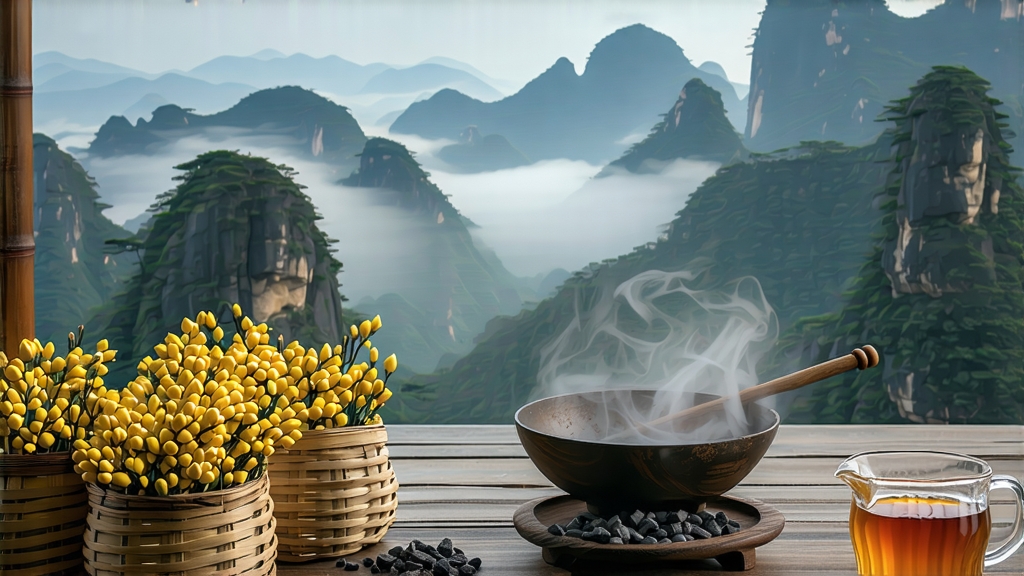
Tucked high in the mist-veiled Dabie Mountains of western Anhui Province, Huoshan Huangya has quietly captivated Chinese emperors, poets, and tea sages for more than seven centuries. Unlike the better-known greens of Longjing or the rock oolongs of Wuyi, this “yellow bud” tea remains a semi-hidden gem, its subtle amber hue and orchid-like sweetness produced by a labor-intensive micro-fermentation step that turns each leaf from jade to primrose. To the international palate—accustomed to the grassy snap of green tea or the malty heft of black—Huoshan Huangya offers a gentle paradox: the freshness of early spring locked inside a mellow, almost creamy cup that seems to glow from within.
Historical whispers place the tea’s tribute status as early as the Ming dynasty (1368-1644), when county annals record “first-pick buds sent by courier to the Forbidden City.” By the Qing, Huoshan cakes pressed with silver foil were reportedly stored in the Imperial Pharmacy, prized both for flavor and for “clearing summer heat.” Foreign visitors first encountered it in 1905 through a Shanghai export house that labeled it “Mellow Anhui,” but revolution, war, and the rise of mass-market greens pushed it to the brink of extinction; in 1972 only two elderly masters still knew the full menhuang (sealed yellowing) protocol. A state-sponsored restoration project in 1979 traced surviving seed gardens, re-established withering huts, and codified the slow charcoal-baking rhythm that defines modern Huoshan Huangya. In 2020 the European Union granted it Protected Designation of Origin (PDO) status, a milestone that now invites global drinkers to rediscover what Chinese court chronicles once called “the gold that can be drunk.”
Botanically, the tea is made exclusively from a local small-leaf cultivar, Huoshan early-sprouting clone, whose shorter internodes yield a higher amino-acid ratio and a natural lilac note. Picking begins when the mountain thermometer hovers just above 5 °C, usually between Qingming and Grain Rain (early April). Only the “flag-and-bud” set—one unopened tip sheathed by a partially opened leaf—is plucked, ideally before 9 a.m. while dew still pearls the surface. A master can harvest barely 500 g of fresh leaf in an hour; 4.3 kg of this are required to finish a single kilogram of tea, explaining why top grades retail for more than silver itself.
The transformation unfolds in five meticulous stages, each calibrated to the mountain’s shifting humidity. First, shaqing (kill-green) takes place in a bamboo-lined wok heated to 160 °C; the leaves are tossed by hand for exactly 90 seconds, just long enough to halt oxidative enzymes while preserving the pale green color. Immediately they are rolled into tight strips using a light “push-press” motion that ruptures fewer than 15 % of cell walls, ensuring a slow, controlled release of juices. The signature menhuang follows: the leaf piles are wrapped in steamed canvas and left in a pine-wood chamber kept at 28–30 °C and 75 % relative humidity for 60–72 hours. During this “sealed yellowing” the chlorophyll gently degrades, catechins partially oxidize, and a unique flora of Thermomyces and Bacillus subtilis produces γ-aminobutyric acid (GABA), the compound credited for the tea’s umami-sweet finish. A low-temperature bake at 55 °C for three hours then locks in the new color, after which the leaf rests for seven days so that residual moisture equalizes. Finally, a sorting hand-fire at 70 °C gives the finished tea its chestnut aroma and allows the master to remove any reddish “flower” leaves that would darken the infusion.
Grading is done by bud percentage and leaf color. Special Grade (Te Ji) must contain ≥ 90 % unopened buds, each measuring 1.5–2 cm, and produce a liquor the color of chrysanthemum honey. First Grade allows 30 % one-and-a-half leaves, while Second Grade permits larger, more mature material; both steep slightly darker and carry a faint cocoa note. Regardless of grade, the dry leaf should smell of fresh bamboo shoot and magnolia, never of green grass or roasted nuts—tell-tale signs that